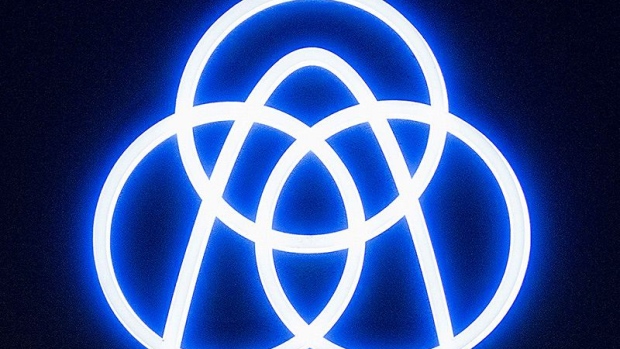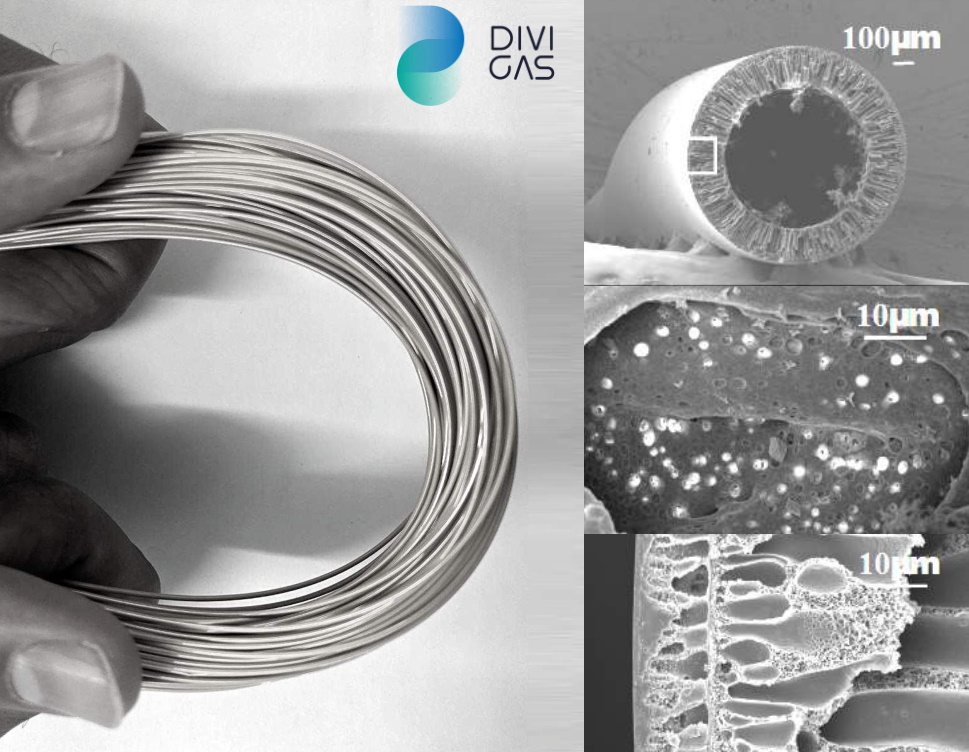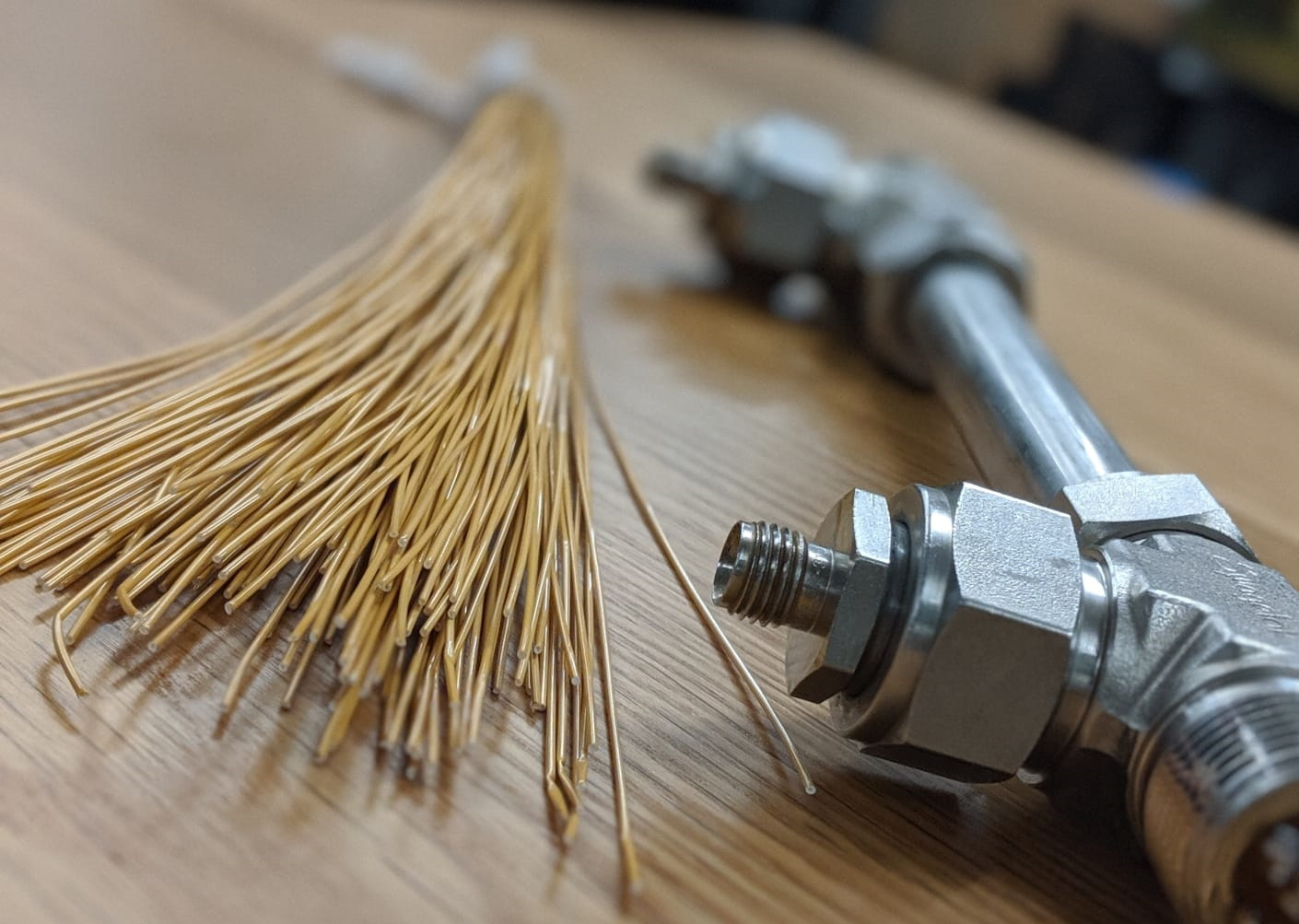ALL H2 IS BLUE
Thyssenkrupp Pushes Ahead With IPO
of $5.7 Billion Hydrogen Unit
, Bloomberg News
The Thyssenkrupp AG logo sits illuminated at the entrance to the company's
steel plant in Duisburg, Germany, on Wednesday, Dec. 20, 2017. 
(Bloomberg) -- Thyssenkrupp AG is pushing ahead with plans for an initial public offering of a unit that helps to build hydrogen plants, according to people familiar with the matter.
The German engineering group is looking to list Uhde Chlorine Engineers as soon as the first quarter of 2022 to capitalize on surging interest in hydrogen-based technologies, the people said. An IPO could value the business at as much as 5 billion euros ($5.7 billion), they said, asking not to be identified discussing confidential information.
Thyssenkrupp has been working with Citigroup Inc. to explore options for Uhde. It previously considered taking the business public via a merger with a special purpose acquisition company before opting for the traditional IPO route, the people said. Thyssenkrupp could appoint more banks in the coming weeks, according to the people.
Deliberations are ongoing and no final decisions on the size or timing of a listing have been taken, they said. A representative for Thyssenkrupp declined to comment, while a spokesperson for Citigroup didn’t immediately respond to a request for comment.
Established as a joint venture with Italy’s Industrie De Nora SpA, Uhde constructs plants that generate hydrogen gas from renewable sources of energy such as solar and wind. Hydrogen converts to electricity without greenhouse gas emissions when fed through a fuel cell or burned in a turbine, and can also be used as a way to store energy.
It’s seen as key to cutting emissions from carbon-heavy industrial processes like chemical production and steelmaking, and they’ve increasingly been attracting money from investors betting on the shift away from fossil fuels. An unprecedented surge in power and natural gas prices has brought the need for diversified energy sources into even sharper focus and helped spur a flurry of green IPOs in Europe.
Thyssenkrupp Chief Executive Officer Martina Merz has overseen a far-reaching restructuring of the group in her bid to improve the fortunes of one of Germany’s last mega-conglomerates. After selling its prized elevator unit last year, Thyssenkrupp reached agreements during the summer to offload smaller mining and infrastructure businesses.
©2021 Bloomberg L.P.
Thyssenkrupp finds lost hydrogen lottery
ticket
LONDON, Nov 17 (Reuters Breakingviews) - Thyssenkrupp (TKAG.DE) has found the corporate equivalent of a winning lottery ticket down the back of the sofa. The 7 billion euro German conglomerate’s shares leapt 12% on Tuesday on hopes it might list its electrolysis division, which is rapidly undergoing a hydrogen-focused makeover . The unit’s sales are negligible. But such is the hype around the gas, a key enabler of the zero-carbon economy, that it may be a multibillion-euro jackpot.
Tuesday’s electrolysis revelation came as a surprise to most analysts covering the group, whose interests range from steel to submarines to car parts. Most ascribed zero value to the unit in their breakdowns of the firm. Last year Thyssenkrupp had to flog its most profitable division – Thyssenkrupp Elevators – to private equity for 17.2 billion euros to shore up its rickety balance sheet.
The oversight is understandable. Thyssenkrupp’s sales in the financial year just completed were 33 billion euros, according to Refinitiv estimates. The lion’s share came from steel and auto-related industrial units. Meanwhile, Chief Executive Martina Merz’s Uhde Chlorine Engineers (UCE) division, which makes kit to split sea water into chlorine and sodium hydroxide, commonly known as lye, had sales of around 250 million euros, analysts reckon.
But this isn’t the real story. UCE’s engineers have tweaked their electrolysers to produce hydrogen from water. Sales are probably only around 10 million euros. But such a paltry sum is immaterial when investor enthusiasm for hydrogen is producing a rerun of the 1990s internet bubble. UK startup ITM Power (ITM.L), which makes a different type of hydrogen electrolyser, has an enterprise value of 2.7 billion pounds, 675 times last year’s 4 million pounds of revenue.
Thyssenkrupp owns two-thirds of UCE; private Italian outfit De Nora holds the rest. But ITM implies the unit could be worth almost as much as Thyssenkrupp’s market value, handing Merz a 5 billion euro windfall. Like ITM, UCE can churn out 1 gigawatt’s worth of hydrogen electrolysers a year. But Thyssenkrupp’s track record with chlorine electrolysis, where it has a 50% market share, lends credibility to its ambitions. It also has some eye-catching early customers, including a $5 billion hydrogen project in Saudi Arabia run by $66 billion U.S. gas giant Air Products (APD.N).
Offloading her elevators for a princely sum on the eve of the pandemic was Merz’s first good call. Her second may be even more lucrative.
CONTEXT NEWS
- Thyssenkrupp is planning to list its Uhde Chlorine Engineers unit, which makes electrolysis equipment, to take advantage of investor interest in the technology underpinning the manufacture of low-carbon hydrogen, Bloomberg reported on Nov. 15.
- The business, a joint venture with Italy’s Industrie De Nora, might be worth as much as 5 billion euros, the news agency said, citing anonymous sources.
- Thyssenkrupp shares enjoyed their best performance in over a year on Nov. 16, closing up 12% at 10.34 euros. The company declined to comment on the report.
With new tech and $3.6M seed, DiviGas aims to clean up hydrogen production

Hydrogen is at the center of many industrial processes and potentially part of major future energy ecosystems, but the process of isolating and storing it is wasteful and expensive. DiviGas, armed with a $3.6 million seed round, hopes to clean up the hydrogen production industry with a new tech that leapfrogs existing methods, potentially supercharging this piece of the new green economy.
While hydrogen itself is generally considered a clean and extremely useful basic element, its production is married to numerous dirty industrial processes. Oil refineries and plastic production, for instance, may give off various hydrocarbons and other mixed gases and chemicals, and to separate them requires further processing and emissions.
One cleaner and simpler option than chemical reactions uses membranes or filters, which essentially separate the H2 and CO2 gases from each other and from other substances in the input stream. But these filters cannot operate at high temperatures, output some gases at low pressures that must be re-pressurized at cost and rapidly degrade in the presence of common acidic gases
Essentially the hydrogen diversion industry — and it’s big, by the way, billions big — is split between an expensive, emissions-heavy option and a cheap, limited option. After meeting in Singapore at one of SOSV’s HAX incubators, the founders of DiviGas plan to provide a third option that has none of the aforementioned weaknesses.
The company claims to have engineered a new “hollow fiber polymeric membrane” at the angstrom scale, which is to say one-tenth of a nanometer. It’s not like they designed a filter the size of an atom, but rather that the functional features of the material are at this scale, producing the kind of highly specialized effect desired — in this case, causing hydrogen and carbon dioxide gas to separate at slightly different pressures, allowing them to be diverted and isolated.
Huge numbers of fibers are bundled together into tubes through which the input gas is forced, with no chemical reactants required. Unlike other membranes, this new one can operate at high temperatures — up to 150 degrees C — and is resistant to common acidic compounds in the gas mix formed from sulfur and chlorine, which means it can handle more caustic and untreated input flows without degrading. And it does so while performing as well or better than the old membranes on basic scales of selectivity (affecting output purity) and permeance (which affects maximum operable pressure).
Because the method is the same in principle as existing membrane techniques, DiviGas’s tech can be substituted in with minimal fuss and modification. And although manufacturing the new fibers is not a trivial task, they aren’t particularly exotic and use many existing processes. As co-founder, CTO and creator of the new material Ali Naderi explained, it’s the result of various cutting-edge innovations but ultimately still easy to manufacture.
“To make it economically viable, we developed a dual-layer hollow fiber membrane to use the functional materials (i.e. expensive materials) as low as possible on the selective layer (i.e. outer layer) and a cheap/commercially available polymer in the mechanical support layer (i.e. inner layer),” he wrote in an email to TechCrunch. “This type of membrane can be fabricated commercially by using a customized spinning line that has the same price as a standard spinning line has.”
The prospect of simpler, cleaner hydrogen and CO2 production has been met with extreme enthusiasm by people in the industry, according to co-founder and CEO Andre Lorenceau.
“We’ve got clients banging down our door, asking us when we can give tens of millions of these things to them,” he said. “This round is us playing catch-up.”
The money is going toward building a pilot-scale plant in Melbourne that should be operational in March; currently it takes months to build a single unit (a usable bundle of fibers) for demonstrations, and a given client might want hundreds or thousands on a regular basis. Once the company is able to build them at a rate of around one a week, they can do larger demonstrations and small installations that will secure serious orders — and those proceeds will go toward building out out the full-scale manufacturing process.
“It’s two or three times more expensive right now, but they don’t care,” Lorenceau said (though the price will come down with volume, he added). “They say, ‘It’s a tech I know, a manufacturing process I know — if you can give it to us at that price it’s Gucci.’ And it’s a lot of clients, and we haven’t even been doing sales.”
The competitive landscape, he added, is conducive to quick action on their part, being full of slow movers and stalled startups.
“There are these giant lumbering corporations, they have a department for this and they do improve, but it’s old guard. Same reason why it isn’t the old PhDs of computer science who build the next generation of software tech — they’re not trying to build next-gen weird shit all the time,” he said. “The startups are also research PhD people who aren’t used to the high-speed VC thing. They have excellent research performance, but in terms of manufacturing, it costs a zillion bucks to make a square inch of the damn stuff. They say, ‘we’ll figure out the manufacturability…’ and they never do. So we can leapfrog them and the big corporations.”
The $3.6 million round was led by Mann + Hummel, a German industrial filter company clearly looking to get ahead of the game. Also participating in the round were Entrepreneur First, Albert Wenger (USV), SOSV/HAX, Energy Revolution Ventures, Amasia VC, Volta.vc and Climate Capital, along with several individual investors.
Alberta Innovates to receive nearly $50 million in new government funding for projects
Author of the article:Kellen Taniguchi

Alberta Innovates is receiving nearly $50 million in government funding for new projects.
In a Wednesday news release, Jobs, Economy and Innovation Minister Doug Schweitzer said the money will help the province become a stronger leader in clean energy technologies.
“Alberta continues to lead in all forms of energy innovation,” said Schweitzer. “Alberta Innovates is building on our strengths by supporting groundbreaking discoveries and commercializing innovative solutions Alberta — and the world — needs.”
Alberta Innovates is a provincial government agency that reports to the jobs, economy and innovation minister.
The funding is being provided to 23 projects. Projects began as early as January 2021 and must be completed by March 2023.
“These projects aim to reduce emissions, reduce water use, increase value, decrease costs and manage waste through new technologies and precesses,” said Laura Kilcrease, CEO of Alberta Innovates.
Alberta Innovates expects the projects to support 1,307 project-related jobs, while contributing $169 million to the province’s GDP.
Approved projects will provide technological solutions for the province’s energy industry in areas such as oil and gas operations, recycling and hydrogen production.
Last week, Ottawa announced an investment of $1.35 million to help Alberta companies engineer and test hydrogen fuel infrastructure, equipment and technologies.
C-FER Technologies, a non-profit subsidiary of Alberta Innovates that provides experimental testing and specialized engineering consulting services out of Edmonton, said it would use that funding to upgrade one of its facilities to help test new products and procedures for hydrogen transportation and storage.
Alberta Innovates said it would chip in another $300,000.



No comments:
Post a Comment